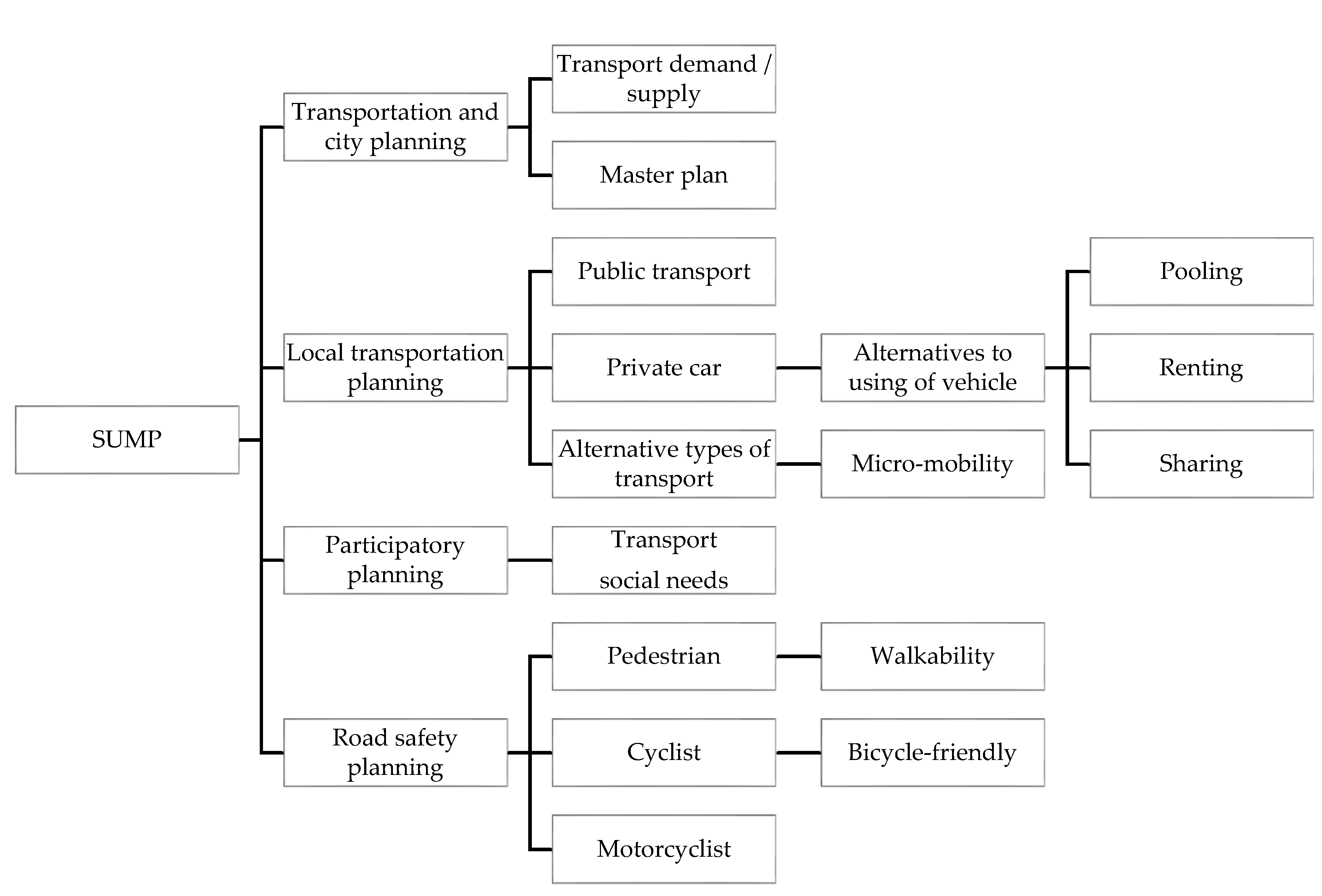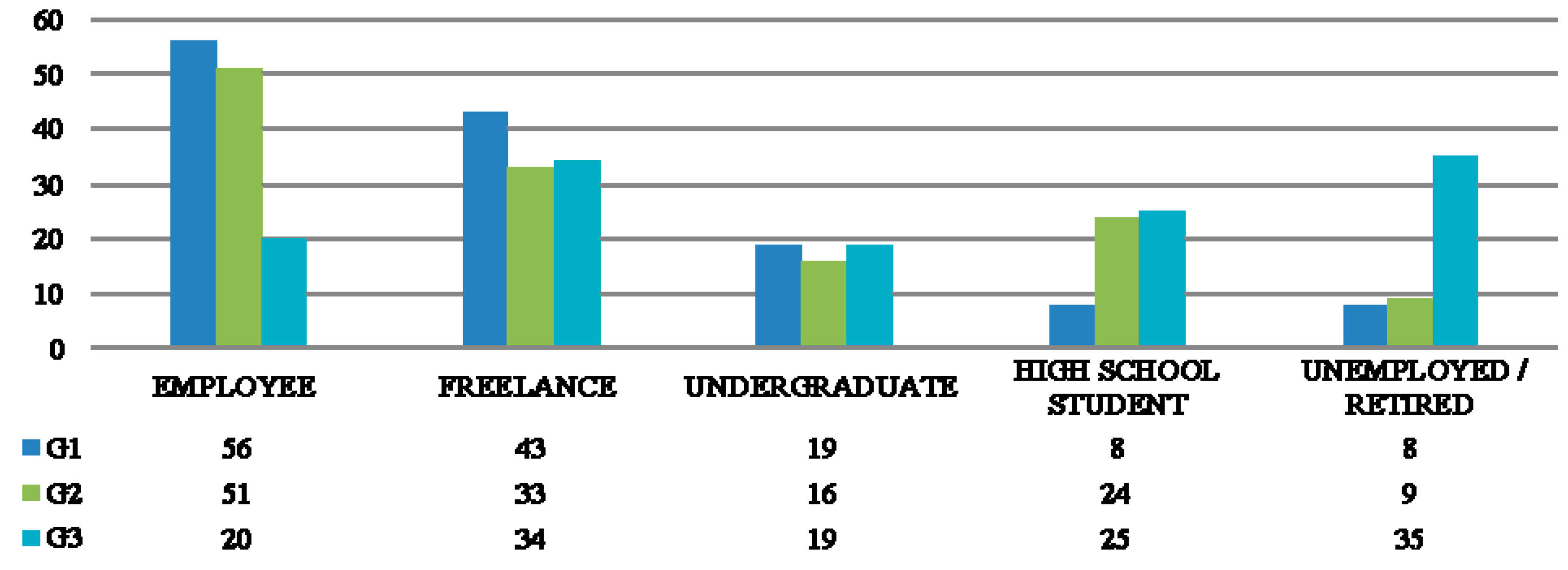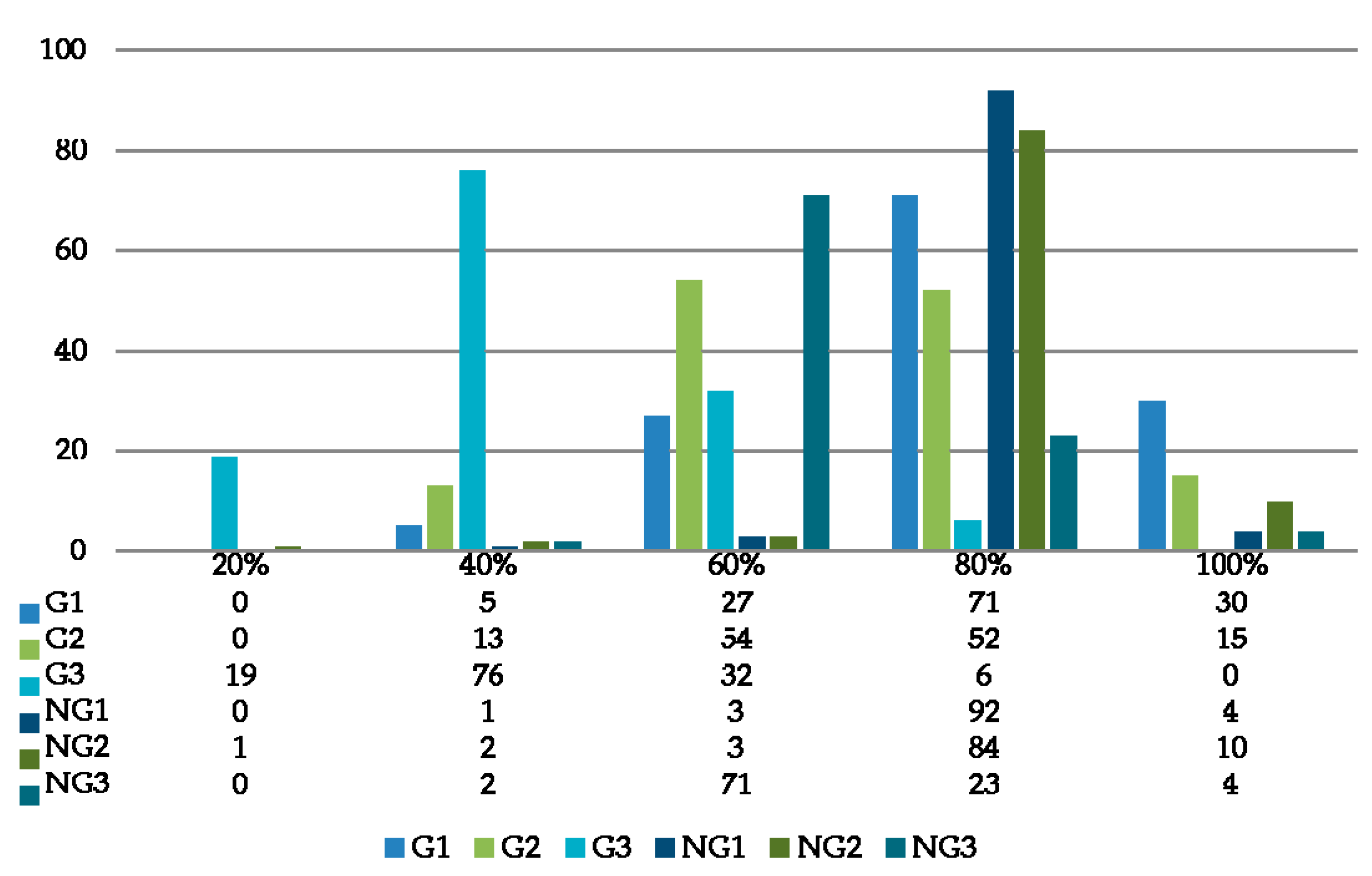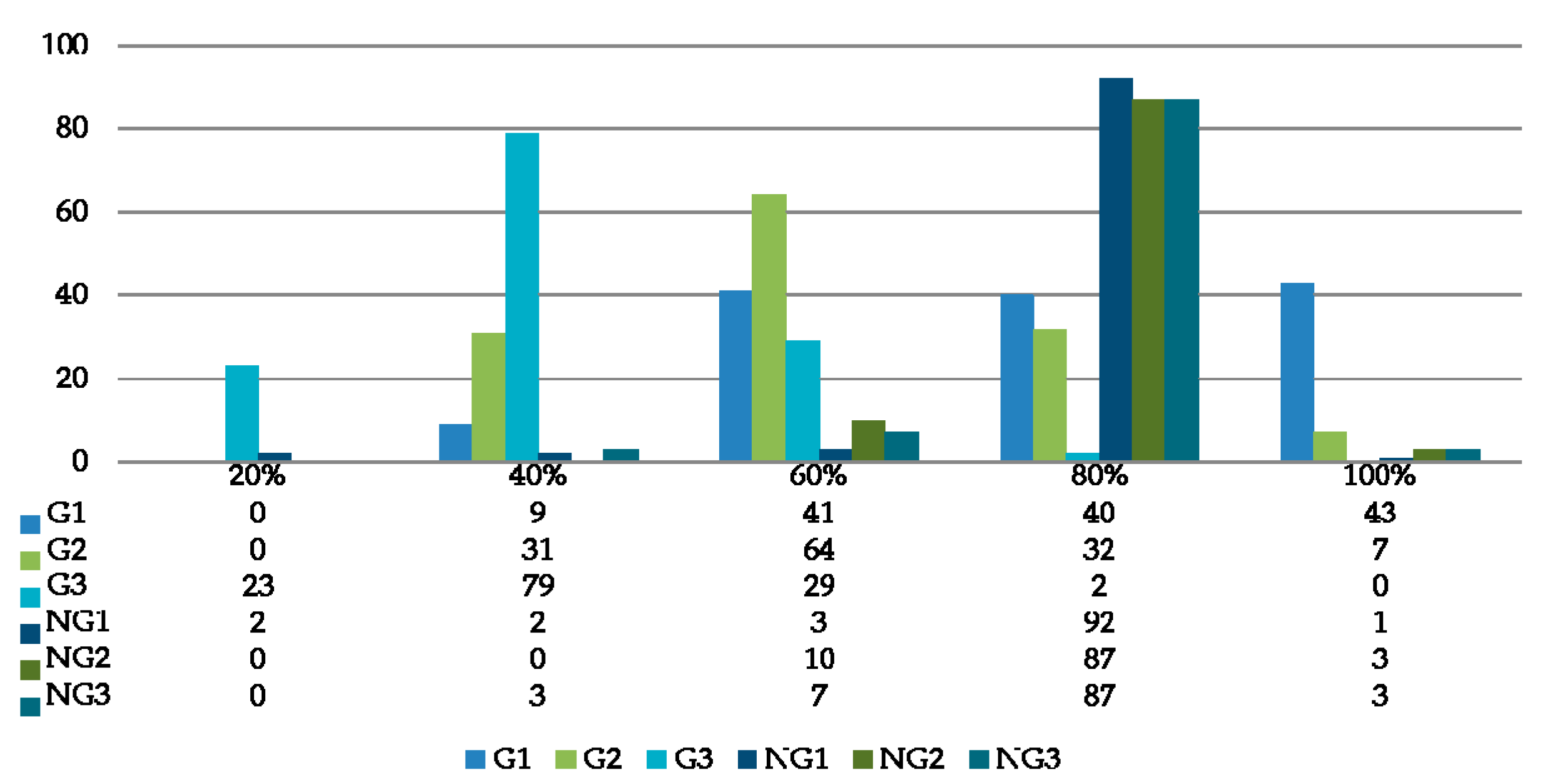Exploring Public Opinion on Personal Mobility Vehicle Use: A Case Study in Palermo, Italy
Abstract
1. Introduction
2. Method
- Dichotomous questions: Yes/No answers, Section A (A4)
- Multiple choice questions: Section A and B (A1, A2, A3, B1, B2, B3, B4)
- Likert scale questions with percentage (%): Section C (C1, C2, C3)
- Likert scale questions with five-point scale (rating from 1 to 5): Section D (D1, D2)
3. Results
3.1. Descriptive Statistics of Sociodemographic Characteristics and Transport Habits
3.2. Comparative Analysis of Perception of Electric Scooters between Local and National Levels
3.3. Chi-Square Test of Independence Between Sociodemographic Characteristics and Public Opinion on Electric Scooters
4. Discussion
Author Contributions
Funding
Acknowledgement
Conflicts of Interest
References
- ACEA. Vehicles in Use—Europe 2019. The European Automobile Manufacturers’ Association. Available online: https://www.acea.be/uploads/publications/ACEA_Report_Vehicles_in_use-Europe_2019.pdf#page=4 (accessed on 27 June 2020).
- BP Energy Outlook 2015. Available online: https://www.bp.com/en/global/corporate/energy-economics/energy-outlook.html (accessed on 10 May 2020).
- Lerner, W. The Future of Urban Mobility: Towards Networked, Multimodal Cities of 2050. Available online: https://robertoigarza.files.wordpress.com/2009/07/rep-the-future-of-urban-mobility-2050-little-2011.pdf (accessed on 10 May 2020).
- Okraszewska, R.; Romanowska, A.; Wołek, M.; Oskarbski, J.; Birr, K.; Jamroz, K. Integration of a Multilevel Transport System Model into Sustainable Urban Mobility Planning. Sustainability 2018, 10, 479. [Google Scholar] [CrossRef]
- Van Wee, B.; Ettema, D. Travel behaviour and health: A conceptual model and research agenda. J. Transp. Health 2016, 3, 240–248. [Google Scholar] [CrossRef]
- Russo, F.; Comi, A. City Characteristics and Urban Goods Movements: A Way to Environmental Transportation System in a Sustainable City. Procedia Soc. Behav. Sci. 2012, 39, 61–73. [Google Scholar] [CrossRef]
- Taniguchi, E. Concepts of City Logistics for Sustainable and Liveable Cities. Procedia Soc. Behav. Sci. 2014, 151, 310–317. [Google Scholar] [CrossRef]
- Kijewska, K.; Iwan, S. Analysis of the Functioning of Urban Deliveries in the City Centre and its Environmental Impact Based on Szczecin Example. Transp. Res. Procedia 2016, 12, 739–749. [Google Scholar] [CrossRef]
- Cavalcanti, C.D.O.; Limont, M.; Dziedzic, M.; Fernandes, V. Sustainability of urban mobility projects in the Curitiba metropolitan region. Land Use Policy 2017, 60, 395–402. [Google Scholar] [CrossRef]
- Louro, A.; Da Costa, N.M.; Da Costa, E.M. Sustainable Urban Mobility Policies as a Path to Healthy Cities—The Case Study of LMA, Portugal. Sustainability 2019, 11, 2929. [Google Scholar] [CrossRef]
- Bhuyan, I.; Chavis, C.; Nickkar, A.; Barnes, P. GIS-Based Equity Gap Analysis: Case Study of Baltimore Bike Share Program. Urban Sci. 2019, 3, 42. [Google Scholar] [CrossRef]
- European Commission. Sustainable Urban Transport Plans. Preparatory Document in Relation to the Follow-Up of the Thematic Strategy on the Urban Environment, European Commission 2007. Available online: https://ec.europa.eu/transport/sites/transport/files/themes/urban/studies/doc/2007_sutainable_urba_transport_plan.pdf (accessed on 10 May 2020).
- Awasthi, A.; Omrani, H.; Gerber, P. Investigating ideal-solution based multicriteria decision making techniques for sustainability evaluation of urban mobility projects. Transp. Res. Part A Policy Pract. 2018, 116, 247–259. [Google Scholar] [CrossRef]
- Lopez-Carreiro, I.; Monzón, A. Evaluating sustainability and innovation of mobility patterns in Spanish cities. Analysis by size and urban typology. Sustain. Cities Soc. 2018, 38, 684–696. [Google Scholar] [CrossRef]
- Kiba-Janiak, M.; Kiba-Janiak, M. Sustainable Urban Mobility Plans: How Do They Work? Sustainability 2019, 11, 4605. [Google Scholar] [CrossRef]
- Kujala, R.; Weckström, C.; Mladenović, M.N.; Saramäki, J. Travel times and transfers in public transport: Comprehensive accessibility analysis based on Pareto-optimal journeys. Comput. Environ. Urban Syst. 2018, 67, 41–54. [Google Scholar] [CrossRef]
- Akgun, N.; Dissanayake, D.; Thorpe, N.; Bell, M. Cyclist casualty severity at roundabouts—To what extent do the geometric characteristics of roundabouts play a part? J. Saf. Res. 2018, 67, 83–91. [Google Scholar] [CrossRef]
- Geda, Y.E.; Roberts, R.O.; Knopman, D.S.; Christianson, T.J.H.; Pankratz, V.S.; Ivnik, R.J.; Boeve, B.F.; Tangalos, E.G.; Petersen, R.C.; Rocca, W.A. Physical Exercise, Aging, and Mild Cognitive Impairment. Arch. Neurol. 2010, 67, 80–86. [Google Scholar] [CrossRef]
- Johnson, M.; Rose, G.; Rose, G. Extending life on the bike: Electric bike use by older Australians. J. Transp. Health 2015, 2, 276–283. [Google Scholar] [CrossRef]
- Emond, C.R.; Tang, W.; Handy, S.L. Explaining Gender Difference in Bicycling Behavior. Transp. Res. Rec. J. Transp. Res. Board 2009, 2125, 16–25. [Google Scholar] [CrossRef]
- Nickkar, A.; Banerjee, S.; Chavis, C.; Bhuyan, I.; Barnes, P. A spatial-temporal gender and land use analysis of bikeshare ridership: The case study of Baltimore City. City Cult. Soc. 2019, 18, 100291. [Google Scholar] [CrossRef]
- Gauvin, L.; Tizzoni, M.; Piaggesi, S.; Young, A.; Adler, N.; Verhulst, S.; Ferres, L.; Cattuto, C. Gender gaps in urban mobility. Humanit. Soc. Sci. Commun. 2020, 7, 1–13. [Google Scholar] [CrossRef]
- WHO. Gender, Equity and Human Rights. World Health Organisation. Available online: https://www.who.int/gender-equity-rights/knowledge/glossary/en/ (accessed on 27 June 2020).
- Umaña-Barrios, N.; Gil, A.S. How Can Spatial Design Promote Inclusivity, Gender Equality and Overall Sustainability in Costa Rica’s Urban Mobility System? Procedia Eng. 2017, 198, 1018–1035. [Google Scholar] [CrossRef]
- Smith, G.; Sochor, J.; Karlsson, M. Mobility as a Service: Development scenarios and implications for public transport. Res. Transp. Econ. 2018, 69, 592–599. [Google Scholar] [CrossRef]
- Wu, Y.; Zhang, L. Can the development of electric vehicles reduce the emission of air pollutants and greenhouse gases in developing countries? Transp. Res. Part D Transp. Environ. 2017, 51, 129–145. [Google Scholar] [CrossRef]
- Barnes, P.J.; Grasso, S.; Chavis, C.; Bhutan, I.A.; Nickkar, A. Bicycle Justice or Just Bicycles? Analyzing Equity in Baltimore’s Bike Share Program. Department of Transportation and Urban Infrastructure at Morgan State University 2018. Available online: http://udspace.udel.edu/handle/19716/24132 (accessed on 30 September 2018).
- Fischer, F. Citizens, Experts, and the Environment; Duke University Press: Durham/London, UK, 2000. [Google Scholar]
- Newig, J. Does public participation in environmental decisions lead to improved environmental quality? Towards an analytical framework. Communication, Cooperation, Participation. Int. J. Sustain. Commun. 2007, 1, 51–71. Available online: https://nbn-resolving.org/urn:nbn:de:0168-ssoar-431965 (accessed on 1 May 2020).
- Koontz, T.M.; Thomas, C.W. What Do We Know and Need to Know about the Environmental Outcomes of Collaborative Management? Public Adm. Rev. 2006, 66, 111–121. [Google Scholar] [CrossRef]
- Richards, C.; Blackstock, K.L.; Carter, C.E. Practical Approaches to Participation SERG Policy Brief No. 1; Macaulay Land Use Institute: Aberdeen, UK, 2004. [Google Scholar]
- Ignaccolo, M.; Inturri, G.; Giuffrida, N.; Le Pira, M.; Torrisi, V. Public Engagement for Designing New Transport Services: Investigating Citizen Preferences from a Multiple Criteria Perspective. Transp. Res. Procedia 2019, 37, 91–98. [Google Scholar] [CrossRef]
- Clewlow, R.R. The Micro-Mobility Revolution: The Introduction and Adoption of Electric Scooters in the United States. Transportation Research Board 2019 No. 19-03991. Available online: https://trid.trb.org/view/1528426 (accessed on 10 April 2020).
- Campisi, T.; Torrisi, V.; Ignaccolo, M.; Inturri, G.; Tesoriere, G. University propensity assessment to car sharing services using mixed survey data: The Italian case study of Enna city. Transp. Res. Procedia 2020, 47, 433–440. [Google Scholar] [CrossRef]
- Child, S.; Luck, F.T.; Schofield, C.; Hopkins, L.; Nampijja, M.; Duff, S.; Taylor, J.; Otero, S.; Mannay, D.; Kefalidou, G.; et al. Reviews: Child Development, Culture and Psychological Development, Discovering Statistics Using SPSS (3rd ed.), Doing Qualitative Research in Psychology: A Practical Guide, Essential Psychology: A Concise Introduction, Movies and Mental Illness: Using Films to Understand Psychopathology (3rd ed.), Psychological Groupwork with Acute Psychiatric Patients, Psychology: The Science of Mind and Behaviour, Theories of Developmental Psychology, Your Psychology Project Handbook: Becoming a Researcher, Loftus Speaks. Psychol. Learn. Teach. 2011, 10, 57–75. [Google Scholar] [CrossRef]
- Sharpe, D. Chi-Square Test is Statistically Significant: Now What? Pract. Assess Res. Eval. 2015, 20, 8. [Google Scholar] [CrossRef]
- McKenzie, G. Shared micro-mobility patterns as measures of city similarity. In Proceedings of the 1st ACM SIGSPATIAL International Workshop on Computing with Multifaceted Movement Data—MOVE’19, Chicago, IL, USA, 5 November 2019. [Google Scholar]
- Jiao, J.; Bai, S. Understanding the Shared E-scooter Travels in Austin, TX. ISPRS Int. J. Geo-Inf. 2020, 9, 135. [Google Scholar] [CrossRef]
- Zagorskas, J.; Burinskienė, M. Challenges Caused by Increased Use of E-Powered Personal Mobility Vehicles in European Cities. Sustainability 2019, 12, 273. [Google Scholar] [CrossRef]








| Section | Variables and Groups of Participants | Question Types | ||||
|---|---|---|---|---|---|---|
| Dichotomous | Multiple Choice | Likert Scale Percentage % | Likert Scale Rating (1–5) | |||
| A | 1 | Gender (G1-G2-G3) | ✓ | |||
| 2 | Age (G1-G2-G3) | ✓ | ||||
| 3 | Employment(G1-G2-G3) | ✓ | ||||
| 4 | Residence place (G1-G2-G3) | ✓ | ||||
| B | 1 | Car license ownership (G1-G2-G3) | ✓ | |||
| 2 | Main reason for moving with own PMV (G-1) | ✓ | ||||
| 3 | Main reason for moving with own private car (G1-G2-G3) | ✓ | ||||
| 4 | Main reason for moving with PT (G1-G2-G3) | ✓ | ||||
| C | 1 | Utility of PMV to reduce the traffic of big cities (G1-G2-G3) | ✓ | |||
| 2 | Electric scooter as an environmentally friendly means of transport (G1-G2-G3) | ✓ | ||||
| 3 | Electric scooter as a quick and convenient system for urban travel (G1-G2-G3) | ✓ | ||||
| D | 1 | Incentive policies to integrate private transport and PT with electric sharing micro-mobility (G1-G2-G3) | ✓ | ✓ | ||
| 2 | Incentive policies to integrate private transport and PT with own electric micro-mobility (G1-G2-G3) | ✓ | ✓ | |||
| Subcategory | Transport Mode | H-W | H-S | H-L | Not Using Car | Not Using PT |
|---|---|---|---|---|---|---|
| G1 | PMV | 87 | 15 | 31 | 0 | 0 |
| Private car | 65 | 13 | 55 | 0 | 0 | |
| Shared mobility | 45 | 40 | 48 | 0 | 0 | |
| PT | 35 | 23 | 75 | 0 | 0 | |
| G2 | Private car | 74 | 13 | 28 | 19 | 0 |
| Shared mobility | 25 | 5 | 85 | 19 | 0 | |
| PT | 3 | 12 | 63 | 0 | 56 | |
| G3 | Private car | 85 | 1 | 22 | 25 | 0 |
| Shared mobility | 77 | 5 | 26 | 25 | 0 | |
| PT | 33 | 4 | 65 | 0 | 31 |
| Subcategories | Transport Combination/Opinion | Likert Scale | ||||
|---|---|---|---|---|---|---|
| 1 | 2 | 3 | 4 | 5 | ||
| G1 | Private car + PT + Sharing PMV | 0 | 5 | 25 | 62 | 41 |
| Private car + PT + Owning PMV | 0 | 3 | 13 | 57 | 60 | |
| G2 | Private car + PT + Sharing PMV | 5 | 26 | 58 | 38 | 7 |
| Private car + PT + Owning PMV | 7 | 24 | 62 | 36 | 5 | |
| G3 | Private car + PT + Sharing PMV | 47 | 39 | 41 | 5 | 1 |
| Private car + PT + Owning PMV | 59 | 21 | 51 | 1 | 1 | |
| Gender (A1) 1 | Age Group (A2) 2 | ||||
|---|---|---|---|---|---|
| Subcategory | Variables | χ2 | p-Value 3 | χ2 | p-Value 3 |
| G1 | C1 | 48.52 | 0.00 | 62.29 | 0.00 |
| C2 | 11.21 | 0.02 | 55.82 | 0.00 | |
| C3 | 12.38 | 0.01 | 12.29 | 0.42 | |
| G2 | C1 | 13.74 | 0.01 | 60.62 | 0.00 |
| C2 | 12.69 | 0.01 | 43.90 | 0.00 | |
| C3 | 6.09 | 0.19 | 57.52 | 0.00 | |
| G3 | C1 | 5.91 | 0.21 | 24.11 | 0.02 |
| C2 | 6.50 | 0.17 | 13.90 | 0.31 | |
| C3 | 3.00 | 0.56 | 18.59 | 0.10 | |
© 2020 by the authors. Licensee MDPI, Basel, Switzerland. This article is an open access article distributed under the terms and conditions of the Creative Commons Attribution (CC BY) license (http://creativecommons.org/licenses/by/4.0/).
Share and Cite
Campisi, T.; Akgün, N.; Ticali, D.; Tesoriere, G. Exploring Public Opinion on Personal Mobility Vehicle Use: A Case Study in Palermo, Italy. Sustainability 2020, 12, 5460. https://doi.org/10.3390/su12135460
Campisi T, Akgün N, Ticali D, Tesoriere G. Exploring Public Opinion on Personal Mobility Vehicle Use: A Case Study in Palermo, Italy. Sustainability. 2020; 12(13):5460. https://doi.org/10.3390/su12135460
Chicago/Turabian StyleCampisi, Tiziana, Nurten Akgün, Dario Ticali, and Giovanni Tesoriere. 2020. "Exploring Public Opinion on Personal Mobility Vehicle Use: A Case Study in Palermo, Italy" Sustainability 12, no. 13: 5460. https://doi.org/10.3390/su12135460
APA StyleCampisi, T., Akgün, N., Ticali, D., & Tesoriere, G. (2020). Exploring Public Opinion on Personal Mobility Vehicle Use: A Case Study in Palermo, Italy. Sustainability, 12(13), 5460. https://doi.org/10.3390/su12135460







